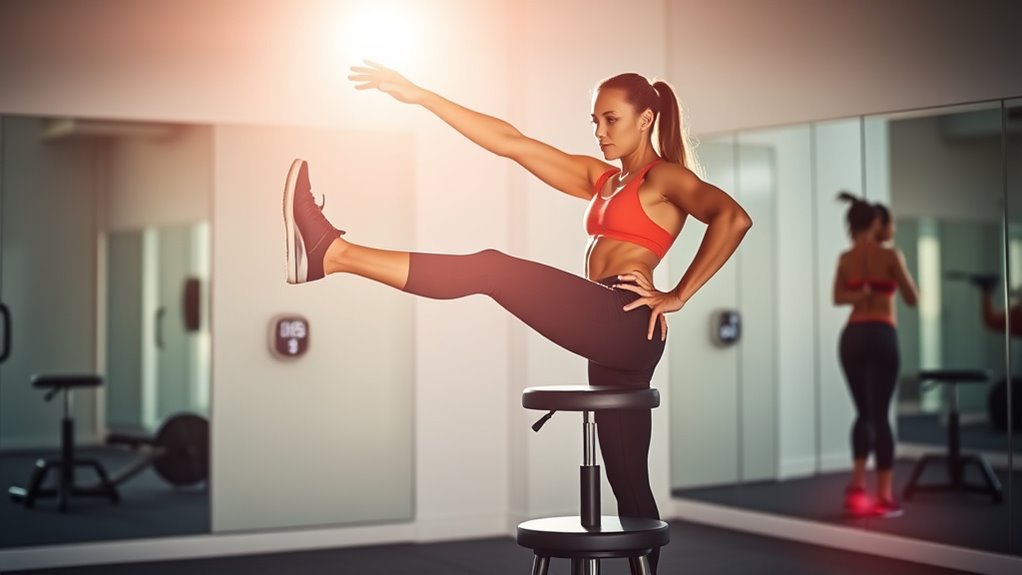To do a quick 10-minute counter-hold balance workout, start with simple holds on a flat surface, gradually increasing duration. Add challenges by lifting one limb or switching to single-leg stances, using equipment like balance discs or foam pads for extra stability. Focus on controlled movements, keeping your core engaged, and breathe steadily. Keep your routines consistent, and if you continue exploring, you’ll discover even more effective ways to improve your balance and strength.
Key Takeaways
- Start with simple balance holds on a flat surface, gradually increasing duration for steady progress.
- Incorporate single-leg stances and arm movements to enhance challenge within 10 minutes.
- Use equipment like foam pads or stability balls to modify difficulty and engage stabilizer muscles.
- Focus on proper form, engaging core muscles, and controlled breathing for safety and effectiveness.
- Practice consistently daily, gradually advancing difficulty for improved balance and core strength.
Effective Progression and Equipment Tips for Balance Exercises

If you’re looking to improve your stability and core strength, a counter-hold balance workout is an effective addition to your fitness routine. This type of exercise challenges your body to maintain balance while engaging multiple muscle groups, especially your core. To get the most out of it, you’ll want to focus on progression techniques that gradually increase the difficulty as your strength and stability improve. Starting with simple holds on a flat surface, you can then advance to more challenging positions, such as lifting one limb or holding the position for longer durations. These progression techniques help prevent plateaus and guarantee continuous development. When considering equipment options, think about tools like balance discs, stability balls, or foam pads that can enhance your training and challenge your stability more effectively. For example, standing on a balance disc introduces an unstable surface that forces you to engage stabilizer muscles more actively. A stability ball can be used to support your hands or feet during the hold, increasing the challenge to your core and improving proprioception. Even a simple yoga block or cushion can serve as a beginner-friendly tool to modify exercises and build confidence before progressing to more advanced variations. When performing the counter-hold balance, focus on maintaining proper form. Keep your core tight and your shoulders relaxed. Engage your abdominal muscles to stabilize your pelvis and spine. If you’re using equipment, make sure it’s positioned correctly and that you’re comfortable with its stability. As you hold each position, breathe steadily and avoid unnecessary tension in your neck or jaw. The key is to stay controlled and avoid rushing through the movements; quality beats quantity. As you progress, consider increasing the duration of each hold or reducing your base of support. For example, shift from a two-legged stance to a single-leg stance or incorporate arm and leg movements to challenge your coordination further. Remember, consistency is vital. Even a quick 10-minute daily routine can greatly improve your balance and core strength over time. Listen to your body and avoid pushing into pain. Instead, aim for controlled, deliberate movements that build confidence and stability with each session. Ultimately, by incorporating progression techniques and exploring various equipment options, you’ll keep your counter-hold balance workouts engaging and effective. They’ll help you develop a stronger, more resilient core and better overall stability—benefits that extend into daily activities and other fitness pursuits.
Frequently Asked Questions
Can Beginners Safely Perform the Counter-Hold Balance Workout?
Yes, beginners can safely perform the counter-hold balance workout if you focus on beginner safety and proper technique. Start slowly, using support if needed, and pay close attention to your posture and alignment. As you gain confidence and strength, gradually increase the duration and challenge. Listening to your body is key, and don’t rush—proper technique helps prevent injury and builds a solid foundation for balance improvement.
How Often Should I Do This Balance Workout Weekly?
You should aim to do the balance workout 3 to 4 times a week, allowing your body enough time for balance progression and exercise adaptations. Consistency is key to improving stability and strength. Start with shorter holds and gradually increase duration as your balance improves. Listen to your body, and if you feel any discomfort, adjust the workout accordingly to prevent injury and support steady progress.
What Are Common Mistakes to Avoid During the Exercises?
To avoid common mistakes and guarantee proper technique, focus on engaging your core, maintaining a steady gaze, and keeping your posture aligned. Don’t let your hips sag or shoulders round, and avoid rushing through the movements. Remember to breathe evenly and stay mindful of your balance. By paying attention to these details, you’ll maximize benefits and prevent injury, making your workout safe and effective.
Are There Any Specific Health Conditions That Restrict Participation?
If you have medical restrictions or injury concerns, it’s best to consult your healthcare provider before starting this balance workout. Certain health conditions, like joint issues or cardiovascular problems, might make some exercises risky. Listen to your body and modify movements if needed. Avoid pushing through pain, and prioritize safety to prevent further injury. Your health comes first, so get professional guidance to ensure the workout suits your specific needs.
How Can I Modify Exercises for Limited Mobility?
Think of your workout as a custom map—you can chart a course that fits your needs. For limited mobility, you can use adaptive modifications, like chair-assisted exercises, to maintain balance and strength. These modifications provide stability and support, making the workout accessible and safe. By customizing your exercises, you stay engaged and confident, ensuring you get the benefits without risking injury.
Conclusion
Now that you’ve mastered the movement, maintain momentum by molding your method with mindful movements and minimal equipment. Remember, consistency creates confidence, and small steps build stronger stability. Keep challenging your balance with clever cues and controlled cues. With commitment and courage, you’ll conquer challenges, cultivate confidence, and carry your core into countless comfortable, carefree, and confident days. Embrace the effort, enjoy the journey, and watch your balance bloom brighter with each balanced breath.









